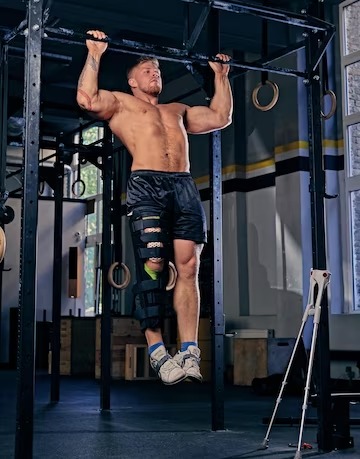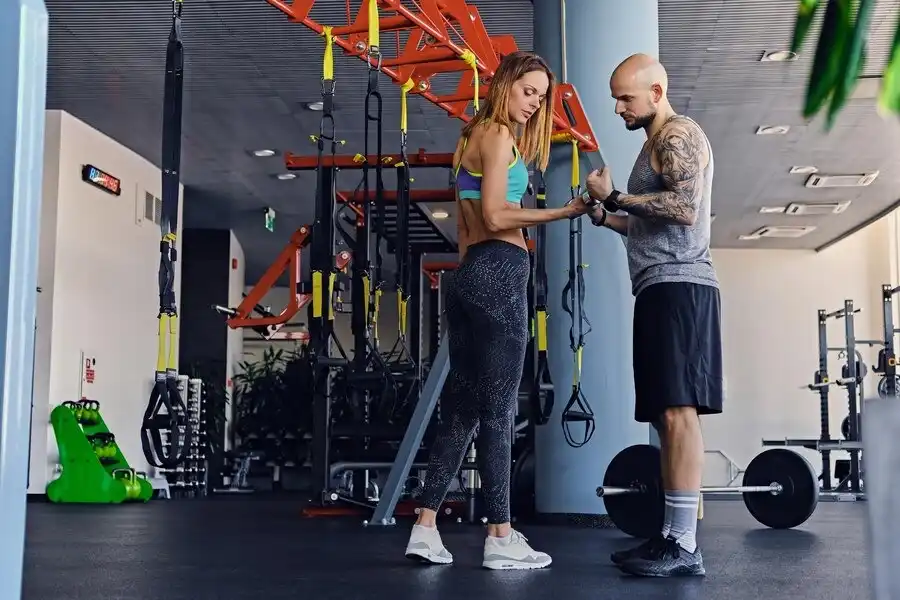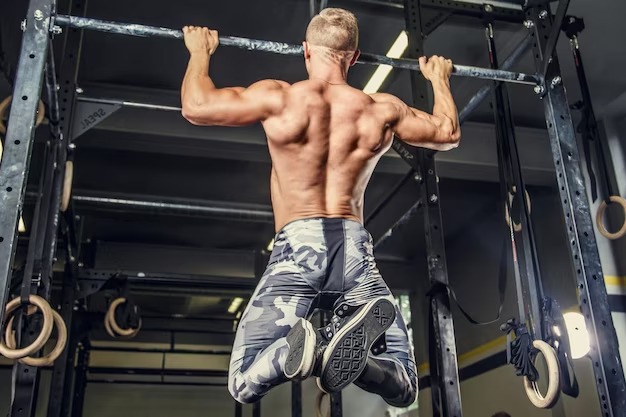Unleash Your Strength: Mastering CrossFit Pull-ups Like a Pro

CrossFit pull-ups are a fundamental exercise within the realm of CrossFit training. These dynamic pull-ups go beyond the traditional pull-up by incorporating explosive movements and increased complexity. They are designed to challenge and improve overall upper body strength, muscular endurance, and functional fitness.
While regular pull-ups primarily focus on the engagement of the back and arm muscles, CrossFit pull-ups introduce a dynamic element that involves utilizing momentum and coordination. This key difference allows CrossFit pull-ups to incorporate additional muscle groups and challenge your fitness abilities in new ways.
In this blog, we will delve into the intricacies of CrossFit pull-ups, covering various aspects to help you enhance your performance. We will discuss the specific muscles targeted by CrossFit pull-ups, proper technique and form, different variations to add variety to your workouts, progressions to advance your skills, and common mistakes to avoid for safe and effective training.
By understanding the foundations and techniques of CrossFit pull-ups, you can unlock the full potential of this exercise and take your CrossFit journey to new heights. Let’s dive in and discover the world of CrossFit pull-ups together.
Understanding CrossFit Pull-ups
CrossFit pull-ups are highly effective in engaging multiple muscle groups simultaneously. The primary muscles targeted during CrossFit pull-ups include the latissimus dorsi (back), biceps brachii (biceps), and deltoids (shoulders). These muscles work synergistically to execute the pulling motion and provide stability throughout the movement.
The latissimus dorsi, commonly known as the lats, are the largest muscles in the back and play a crucial role in pulling movements. They are responsible for the initial contraction and shoulder adduction during CrossFit pull-ups. The biceps brachii, located in the upper arm, act as synergists and assist in elbow flexion, contributing to the pulling action. The deltoids, or shoulder muscles, aid in shoulder abduction and adduction, providing stability and control during the movement.
CrossFit pull-ups encompass both kipping and strict variations. Kipping pull-ups involve using a combination of momentum and coordinated movements to generate upward force and increase the number of repetitions performed. The kipping technique allows for a higher repetition volume and can be more metabolically demanding.
On the other hand, strict CrossFit pull-ups prioritize strength and control. In strict pull-ups, the emphasis is on using only the muscles mentioned earlier without utilizing momentum or excessive swinging. This variation enhances muscular strength and endurance, providing a solid foundation for advanced movements.
Proper execution of CrossFit pull-ups requires a strong grip and an engaged core. Grip strength is vital for maintaining a secure hold on the pull-up bar throughout the movement. Developing grip strength not only enhances performance in CrossFit pull-ups but also translates to improved performance in various other exercises.
Core engagement plays a crucial role in stabilizing the body and generating power during CrossFit pull-ups. A strong core helps maintain proper body alignment, reducing the risk of injury and allowing for more efficient force transfer during the exercise. Activating the core muscles also assists in preventing excessive swinging or momentum during kipping pull-ups.
By understanding the specific muscle groups involved and the dynamic nature of CrossFit pull-ups, as well as the importance of grip strength and core engagement, you can optimize your performance and maximize the benefits of this exercise.
Performing CrossFit Pull-ups Correctly
To perform CrossFit pull-ups correctly, follow these steps:
- Start by grasping the pull-up bar with an overhand grip slightly wider than shoulder-width apart. Ensure your palms are facing away from you.
- Hang freely from the bar with your arms fully extended, keeping your shoulders relaxed and your body in a straight line.
- Initiate the movement by engaging your lats and pulling your shoulder blades down and back. This helps activate the muscles in your back and prepares you for the pull.
- Simultaneously, engage your core and initiate a controlled and controlled upward pull, aiming to bring your chest towards the bar.
- As you begin to ascend, initiate the kipping motion by forcefully extending your hips and legs while keeping your arms engaged.
- At the peak of the upward movement, pull your chin above the bar, aiming to touch your chest to the bar.
- Lower yourself back down in a controlled manner, maintaining tension in your muscles throughout the descent.
- Repeat the movement for the desired number of repetitions, focusing on maintaining proper form and control.
In CrossFit pull-ups, the kipping motion refers to the strategic use of a swinging motion generated by the hips and legs to assist in pulling the body upward. The kipping motion allows for a faster and more efficient cycle time, enabling athletes to perform a higher volume of repetitions compared to strict pull-ups.
The kipping motion helps in generating momentum, making the movement less reliant on pure upper-body strength alone. It allows for a continuous flow of movement by utilizing the hips and legs to drive the upward pull, while the upper body muscles still play a significant role in initiating and controlling the motion.
To maintain control and prevent common mistakes during CrossFit pull-ups, consider the following tips:
- Focus on proper body alignment: Maintain a straight line from your head to your heels throughout the movement, avoiding excessive arching or sagging.
- Avoid excessive swinging: While the kipping motion involves some degree of swinging, aim to control the movement and avoid excessive swinging or flailing of the legs.
- Engage your core: Keep your core muscles engaged throughout the exercise to stabilize your body and facilitate controlled movement.
- Use an appropriate grip: Find a grip that feels comfortable and secure for you. Experiment with different grips, such as pronated (overhand) or mixed (one hand overhand, one hand underhand), to find the grip that suits you best.
- Practice controlled descents: Lower yourself back down in a controlled manner, resisting the temptation to drop quickly. This helps build strength and control throughout the entire range of motion.
By following these guidelines, you can perform CrossFit pull-ups with proper form and technique, incorporating the kipping motion effectively while maintaining control and avoiding common mistakes. This will help you maximize the benefits of CrossFit pull-ups and progress in your training.
Benefits of CrossFit Pull-ups
- Upper Body Strength: CrossFit pull-ups are a highly effective exercise for building upper body strength. The pulling motion engages the muscles in the back, including the latissimus dorsi (lats), rhomboids, and trapezius. Additionally, the biceps and muscles in the shoulders, such as the deltoids, also play a significant role in the movement. Regular practice of CrossFit pull-ups helps strengthen and develop these muscles, resulting in increased upper body strength.
- Muscle Development: CrossFit pull-ups are a compound exercise that targets multiple muscle groups simultaneously. By engaging the muscles in the back, arms, and shoulders, CrossFit pull-ups promote overall muscle development and create a balanced physique. The dynamic nature of the exercise, especially when incorporating kipping motion, allows for a higher volume of repetitions, stimulating muscle growth and endurance.
- Functional Fitness: CrossFit pull-ups are a functional exercise that mimics real-life movements involving pulling and climbing. These movements translate to improved functionality in activities like lifting, carrying, and climbing. By strengthening the muscles involved in pulling motions, CrossFit pull-ups enhance overall functional fitness and make daily tasks easier to perform.
- Grip Strength: CrossFit pull-ups require a strong grip to hold onto the pull-up bar throughout the movement. Regular practice of CrossFit pull-ups helps improve grip strength, which is essential for various activities, such as lifting weights, performing gymnastics movements, and participating in sports. Increased grip strength enhances overall performance and reduces the risk of dropping objects or losing grip during physical activities.
- Shoulder Stability: CrossFit pull-ups demand shoulder stability to perform the movement effectively and safely. The pulling motion engages the muscles around the shoulder joint, including the rotator cuff muscles. By strengthening these muscles and improving shoulder stability, CrossFit pull-ups help reduce the risk of shoulder injuries and enhance overall shoulder function.
- Body Control: CrossFit pull-ups require coordination, body awareness, and control. The kipping motion, in particular, challenges an individual’s ability to synchronize movements between the upper body, core, and lower body. By practicing CrossFit pull-ups, individuals can develop better body control, coordination, and kinesthetic awareness.
By incorporating CrossFit pull-ups into a fitness routine, individuals can experience the benefits of increased upper body strength, overall muscle development, improved functional fitness, enhanced grip strength, improved shoulder stability, and better body control. Regular practice and progression in CrossFit pull-up training can lead to significant improvements in these areas, contributing to overall fitness and athleticism.
Equipment for CrossFit Pull-ups
- Pull-Up Bar: A sturdy pull-up bar is the primary equipment for performing CrossFit pull-ups. Pull-up bars come in various types, such as wall-mounted bars, ceiling-mounted bars, and freestanding bars. It is important to ensure that the pull-up bar is securely mounted and can support your body weight.
- Gymnastics Rings: Gymnastics rings provide an alternative and challenging option for performing CrossFit pull-ups. They offer a greater range of motion and instability, which engages more muscles and challenges stability and control. Gymnastics rings can be hung from a secure structure or mounted on a rig or a pull-up bar.
- Resistance Bands: Resistance bands can be used to assist individuals in performing CrossFit pull-ups, especially for beginners or those working on building strength. By looping the resistance band around the pull-up bar and placing the knees or feet in the band, individuals can reduce the amount of body weight they need to pull, making the exercise more achievable.
- Stability and Durability: Choose equipment that is stable and durable, capable of supporting your body weight and enduring intense workouts. Ensure that the pull-up bar or rings are securely mounted or designed to withstand the forces applied during CrossFit pull-ups.
- Adjustable Height: If using a wall-mounted or ceiling-mounted pull-up bar, consider the height and adjustability. It should allow you to comfortably hang with your arms fully extended and provide enough clearance for your head and feet during the exercise.
- Comfort and Grip: Look for equipment with a comfortable grip, such as textured or padded handles, to prevent slipping and enhance grip strength. Gymnastics rings should have adjustable straps to accommodate different hand sizes and grip preferences.
- Portability: If you prefer to work out in different locations or have limited space, consider portable options like travel pull-up bars or suspension trainers. These can be easily set up and taken down, allowing you to perform CrossFit pull-ups wherever you go.
- Doorway Pull-Up Bar: A doorway pull-up bar is a convenient option for individuals who cannot install a permanent pull-up bar. It can be easily mounted on a door frame and provides a stable structure for performing pull-ups.
- Park or Playground: Public parks or playgrounds often have outdoor fitness equipment, including pull-up bars or monkey bars. These can be utilized for CrossFit pull-ups, allowing you to enjoy outdoor workouts and explore different environments.
- Bodyweight Rows: Bodyweight rows, also known as inverted rows, are a modification of the pull-up that can be performed using a barbell in a rack or a sturdy table. By adjusting the height of the bar or table, you can simulate the pulling motion of a pull-up and engage similar muscle groups.
Remember, the key is to adapt and find alternative options based on your training circumstances. Whether using traditional equipment or improvising with alternative options, the goal is to create a safe and effective environment for performing CrossFit pull-ups and progressing in your training.
In Crux
CrossFit pull-ups offer a challenging and effective way to enhance upper body strength and functional fitness. By incorporating CrossFit pull-ups into your training routine, you can experience significant improvements in your overall strength, muscle development, and body control. These dynamic exercises engage multiple muscle groups, including the back, biceps, and shoulders, making them a valuable addition to any fitness program.
One of the remarkable aspects of CrossFit pull-ups is their versatility and scalability. Whether you are a beginner starting with assisted variations or an advanced athlete performing strict or kipping pull-ups, CrossFit pull-ups can be tailored to your fitness level and goals. The ability to modify the exercise and progress gradually allows individuals of all backgrounds and abilities to participate and experience the benefits.
As with any exercise, it is crucial to prioritize proper form, technique, and safety when performing CrossFit pull-ups. Focus on maintaining a stable core, engaging the targeted muscles, and avoiding common mistakes such as excessive swinging or relying solely on momentum. Gradual progression is key to building strength and avoiding overuse injuries. Listen to your body and gradually increase the difficulty and intensity of your CrossFit pull-up training over time.
In conclusion, CrossFit pull-ups are an excellent addition to any fitness routine, offering numerous benefits for strength, muscle development, and functional fitness. Embrace the challenge, adapt the exercises to your level, and enjoy the journey of improving your upper body strength and function. With consistency, proper form, and gradual progression, CrossFit pull-ups can help you achieve your fitness goals and unlock your full potential.
Thank you for joining us on this fitness journey! We hope you found our The Ultimate Guide to CrossFit Pull-ups: Mastery Tips and Techniques? blog insightful and inspiring. Our aim is to provide you with valuable information, expert advice, and motivational content to support you in your wellness endeavors.
Related Post :-
- How To Do Wall Pushups
- Hand Size Demystified
- CrossFit Unleashed
- Barbell Lunges
- Forearm Fortitude
- Kettlebell Circuit
- Power of Personal Trainers
- Down Pull-Ups
- Best time to drink Proteins Shakes
FAQs about CrossFit Pull-ups

Meet Pradeep Singh, your go-to guide for all things fitness, health, and motivation. With over 7 years in the field, Pradeep brings a blend of expertise and real-world experience to his writing. From workout tips to healthy living insights, he simplifies complex topics, making fitness accessible for everyone. His authentic approach and genuine passion aim to inspire and support your wellness journey. Get ready to embark on a path to a healthier lifestyle with Pradeep as your trusted companion and motivator.





















